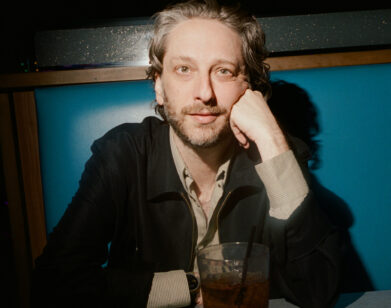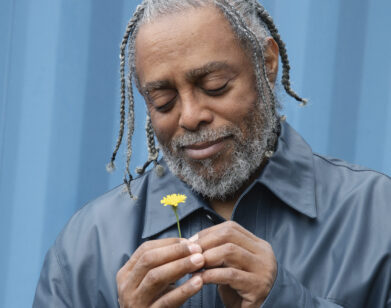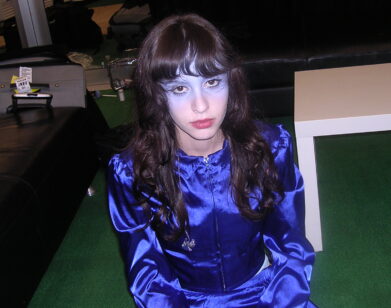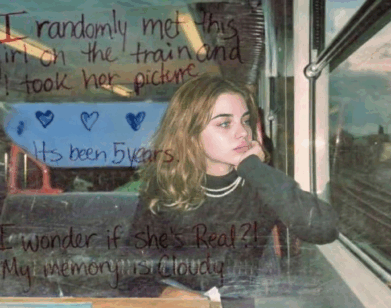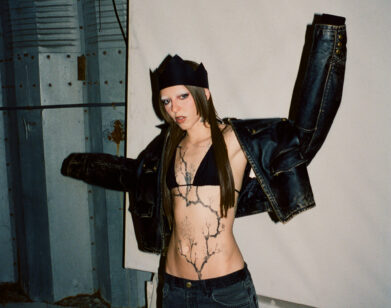David Byrne

David Byrne, the former Talking Heads front man, has been working solo and in what Robert Fripp once called small, independent, mobile, and intelligent units since the Heads split in 1991. One particularly small, independent, mobile, and intelligent unit was Brian Eno-David Byrne, which was actually formed during the time Eno was producing the Talking Heads. In 1981 Byrne and Eno collaborated on the LP My Life in the Bush of Ghosts, an extraordinary mix of fourth-world funk and found vocals. Since then they’ve kept in touch and now have a new album, Everything That Happens Will Happen Today, which is really, really, really good. It brings together the best of both geniuses with songs that sound like folk songs for ultramodern folks. Mr. Byrne has never been in better voice, and Mr. Eno hasn’t been this perfectly pop since “Burning Airlines Give You So Much More” [1974]. Now Byrne is taking this show (including songs by Talking Heads and from My Life . . . ) on the road, hopefully to a venue near you. I talked to him about this and other recent projects at his office just down the street.
GLENN O’BRIEN: Oh, you have art from the Odd Fellows!
DAVID BYRNE: I like this kind of art. I also like those great pictures of all the grand pooh-bahs. It goes a long way in creating some atmosphere in here.
GO: I used to collect lodge paraphernalia. There’s a lot of it. You know, in their heyday, they had
maybe 4 million Masons in the United States.
DB: Yeah. And there were the Odd Fellows and all these other organizations.
GO: There’s a big scandal going on now with the Shriners about misappropriation of funds; they’re still one of the richest charities in the United States.
DB: Those are the guys who drive the little cars and all that stuff.
GO: Mm-hmm.
DB: Could be the end!
GO: Yeah. I think secret societies aren’t what they used to be. Anyway, I love your new record.
DB: Thank you! I was surprised how it came out.
GO: How did it come about, your working with Brian Eno again?
DB: We’d kept in touch, but then we got more in touch over the last few years because Nonesuch -reissued the Bush of Ghosts record [in 2006].
GO: Yeah. That record has something very now about it. It’s actually sitting on my stereo in the country. The found-vocals concept was really ahead of the curve, ahead of the hip-hop producers.
DB: Brian and I kept in touch and have had dinners together. We visit when he’s in New York or when I’m in London. So one thing led to another, and he had some tracks that he said he was working on, and he didn’t know quite how he wanted to finish them. I offered to give it a try because I remembered at one point he said, “I hate writing words.” And I thought, Well, I don’t exactly enjoy it, but I know how to do it. So I said I would give it a try. I said, “We’ll just try a couple and see what happens. We won’t say we’re making a record.” I think those tracks sat on my computer for almost a year. [laughs] Maybe I was afraid to touch them. I didn’t know what direction to take. But I kept in touch with Brian, and I said, “Well, this is the vibe I’m getting from your tracks. Does that seem right? I haven’t done anything yet.” And eventually I just dove in and wrote melodies and words for a couple of them. That pretty much did it. We liked what happened. We just kind of got on a roll after that. And then we realized we had a record.
GO: The record is really seamless. I mean, it has elements familiar to both of your work, but they blend surprisingly well. It has a lot of flavor of the stuff you’ve done, but it also seems to hark back to aspects of Brian’s early solo albums, which were so good. It’s a playful record, but somehow it has a very a soulful atmosphere.
DB: Some of the tracks sound like folk songs.
GO: It’s the folksiest thing you’ve ever done.
DB: [laughs] Yeah.
GO: Or he’s ever done.
DB: I’ll say!
GO: And it’s also really romantic. Are you getting romantic in your old age?
DB: Oh, I think everybody does a little bit. It seemed like the songs were sometimes getting too personally romantic, and so I’d change a word here and there-when it seemed they were sort of turning into love songs. I thought, Okay, I’ve gotta pull these back, because from us it has to be a kind of universal thing.
GO: I think it comes across as that. I mean, it’s not quite Leonard Cohen-romantic. [Byrne laughs] It’s more like I’m-in-love-with-the-universe kind of stuff. Brian’s good at that feel, too. Maybe it’s from hanging around with U2. So with this record were you actually in the same room with Brian at any point?
DB: At the end, yeah. Or near the end. I mean, only for about a week. I went over to London, and we kind of hammered some of the songs into shape. I sang a couple there. But most of it was e-mailed back and forth, which worked amazingly well. We’ve worked together a bunch, and we had that kind of easy division of labor.
GO: Well, not knowing much technically about making music with computers, can you actually
e-mail a guitar track or something like that?
DB: Yeah, yeah. Later on I could do that. That’s amazing, when you can go, “Oh, I just did a guitar solo for that one. Here it is. Just plop it in there.”
GO: It’s funny, there’s a picture in The New York Times today, on the cover of the Arts section, of some kid playing a Mac laptop in concert.
DB: Oh, I saw that.
GO: And he’s, like, in his underwear, bending over it like it’s a keyboard, you know?
DB: [laughs] It looks like, “Guy, you’re gonna step on it!” or, “It’s gonna fall into the mosh pit!”
GO: What happens if your hard drive crashes in the middle of a solo?
DB: You basically just have to walk away. There’s not much you can do.
GO: So is it just you and Eno on the album?
DB: There are a few other musicians. I guess Brian has been working with this guy Leo Abraham, a guitar player. He also plays with the guy from Pulp-the guy with the glasses.
GO: Jarvis Cocker?
DB: Yes. And he’s great-a very inventive guitar player. I think Brian has had him come around to the studio occasionally. So he’s on there a lot [but not credited]. Brian oversaw the drummer adding stuff, and I oversaw a percussionist I work with adding stuff. There are a few little odds and ends like that. But for the most part, it’s built around Brian’s stuff that he does. The direction the music took was a surprise-the whole kind of folkie, spiritual thing.
GO: Will you perform this stuff?
DB: Yeah, I’m gonna do it. Well, not all of it. I think, as much as I’d like to, that can make audiences go crazy, when artists go out and announce, “I’m only gonna do my new record.”
GO: Yeah. What about “Psycho Killer”? [laughs]
DB: So I’ll do some of the record and mix it. I’m gonna mix it with old stuff that Brian and I did, maybe a Bush of Ghosts song-we did three Talking Heads records together, so I can draw on all that as well to emphasize our collaborations.
GO: You’re also doing a record with Fatboy Slim.
DB: Yeah, that’s been a long process, and it’s not finished yet. I wanted to do a kind of . . . I guess you’d call it a disco musical about Imelda Marcos. I did research and discovered there was this story not just about her but about the woman who raised her-their parallel lives, and how they became estranged, and how now and then their paths cross again. Imelda spent a lot of time here in New York, going to clubs. She converted a floor of her New York townhouse into kind of a club with a mirror ball and everything. So I thought, Well, maybe the dance club would be a good setting. At first I thought, Wouldn’t it be great if you could go to a dance club and, in the course of the evening, not only hear music and dance if you want but also feel like you’ve gotten a story out of your whole evening, maybe by osmosis? You don’t have to sit and watch a whole stage thing. I don’t know if that’ll ever happen, but that was the original idea, and so I thought Norman [Cook]-Fatboy Slim-seems to work in a few different genres, though he’s mainly known for a couple of styles. I approached him and said, “Hey, how about this?” Similar to the Brian thing, I suggested he mainly do the beats and some of the music, and I would write on top of that. And it kind of worked both ways. Sometimes I would have a tune and send it to him, and he would put beats to it, and sometimes he would send me stuff. So the music is, for the most part, done-and then I realized it didn’t have a book, as they say on Broadway.
GO: I might have what you need.
DB: A book? [laughs]
GO: I can send you the interview with Imelda Marcos that Bob Colacello did for Interview-she talks about the disco in her apartment.
DB: Oh, my God. There might be some quotes I could use there. [laughs] So I invited all these different singers . . . I thought I’d do a record where different singers do different songs. Sharon Jones did one-kind of a more soulful song where she’s talking about all the different people she’s met and how excited she is to have met all these designers and the queen of Spain or whatever. And I did one the other day with Santi White, the Santogold singer. She was just great. It’s a song about the later years, when Imelda decided to do what she called handbag diplomacy. If she felt the Philippine interests weren’t being served, she would jump on a jet and go talk to Chairman Mao or Gadhafi or whomever. She was her own Henry Kissinger. So, yeah, there’s a song about that.
GO: She was kind of Nancy Reagan before Nancy Reagan. She seemed to be the brains of the regime.
DB: Certainly by that point-I think her husband was pretty ill. In one of the books I read, there
are pictures of the palace bed, and then surrounding the bed are dialysis machines for him and mattresses on the floor where the family would sometimes sleep around him. Quite a scene-very theatrical. It would make a good stage setup.
GO: Do you have any songs about shoes?
DB: Well, the shoes . . . I was wary of them because I thought that’s all she’s known for, and it turns out that they weren’t really discovered until she fled. They all fled the palace, and the mobs rushed in and saw all these shoes and gasped. But, for me, the story is over when they leave the palace. So I never get to the shoes, and I also never get to . . . There’s other stuff that was discovered. They discovered a house on the palace grounds, and when they opened it up, the entire house-every room-was filled to the top with boxes of Heinz Sandwich Spread. One book described this as her “Rosebud.” I guess Imelda’s family didn’t have much money when she was growing up, so she longed for those kinds of trappings. And when she could get things like that, she just hoarded them.
GO: I read an interview recently with Laurence Graff, who sells the most expensive diamonds in the world. He started out as a poor kid in South Africa and conquered the diamond business. One of the great stories he tells is about getting kidnapped by Imelda. He went to sell her this golf ball-size diamond, and she says, “Come with me,” and they get into a car, and she sweeps him off to this island where she had a secret palace. And he spends three days there and winds up selling her a diamond as big as the Ritz, but nobody knew where he was. He couldn’t call anybody-to all the world he was just kidnapped.
DB: But she probably thought she was giving him a lovely trip! She was getting to know this guy.
GO: Oh, he was very happy in the end. But how did you get onto her as a subject?
DB: Kind of by accident. I wanted to do something about a powerful person, about what makes them tick, what drives them to become powerful, and how they inevitably make excuses to themselves about some of the things they do. I read somewhere about her visiting Studio 54 and then turning the rooftop of the Manila palace into a disco. I just thought, Whoa, this was a powerful person, but she kind of created her own soundtrack for her life.
GO: I read somewhere that Mrs. Duvalier had a disco room in the President-for-Life’s palace in Port-au-Prince [Haiti], which was refrigerated like a meat locker so she and her friends could all wear their fur coats in the tropical heat.
DB: Oh, they had all heard about the clubs in New York and Paris, and it seemed to be something to envy.
GO: Yeah, she couldn’t get to Studio 54 every night, so she made her own. Anyway, I wanted to talk about Playing the Building, the project you did with Creative Time where you actually turned
a building into a giant musical instrument.
DB: It’s been really popular, which is thrilling. Anne Pasternak at Creative Time e-mails me and says, “Guess how many people have been here!” It’s great.
GO: How did this idea come about?
DB: Anne had connected me with a guy in Stockholm, Jan Åman, who has an alternative-art space there, an old factory. He invited me to have a show there. It could have been artwork I was doing or an installation or anything. He wasn’t sure what. And I looked at the place-you have girders up top and pipes and metal columns and things like that-and I realized, “Oh, this could all make noises. It could be rigged up and attached and brought down to a central controller, and that would probably be a lot of fun for people.” One of my other proposals was to have a giant, walk-in microwave oven turned to low-just enough so that you could feel the warmth when you walked in. I did research on that, and doctors said no.
GO: The oncologist told you it wasn’t a good idea?
DB: Yeah, this was not a good idea because once you feel the warmth, the microwave has already cooked you. [laughs] So I decided to go with the other idea, and we did it in this factory in Stockholm. I wanted to find a place to do that here in New York, and Creative Time made it possible. I couldn’t have done that alone because it was about a two-year process of going through city bureaucracy and looking at abandoned buildings, and then my looking at them and saying no. I rejected a lot of spaces. A year ago there were still meat-market buildings with racks for beef and lots of stuff hanging from the ceiling, which would make a lot of noise, but then the project would have been very particular to that kind of industry, and I thought, “Oh, no. Then it’s like playing an
abattoir as opposed to just playing a building.”
GO: Remember the Cooler? That was a club in an abattoir. Well, a meat locker anyway. It was a good venue for James Chance and the original Contortions. [both laugh] Who has played the building, aside from yourself? Have you had guest artists in there?
DB: I’ve heard from a few musicians and artists and people who’ve gone down there. But it’s a pretty wide range-it’s folks our age, and then little kids and school groups come in and they jump all over this thing.
GO: It’s funny. I hadn’t seen much of you for a long time, but in the last year or two I’ve been seeing you whiz by on a bike. Is bicycling a new thing for you?
DB: I started doing it a long time ago. I used to live in the East Village, on 7th Street and Avenue A, and I’d bike down to the Mudd Club or whatever. It was probably dangerous riding back from there at whatever time in the morning it would be, but I was riding around back then, kind of sporadically. And I guess in the last decade I’ve realized I could get around town a lot more easily. There are a few more bike lanes and there’s the bike path up the Hudson River. I’ve been kind of, well, not a maniac about it, but I have stuck to it. Now, I’m sure they sent you information about the bike racks I did.
GO: Yeah, yeah. How did that happen?
DB: I got to know some of the city people. They know I’m a bike rider and I occasionally would meet with this group, Transportation Alternatives-their name tells you what they’re about-and they’re doing these new bike racks, newly shaped things, different from what they usually have. And there was a design competition, and the Department of Transportation asked me to be one of the judges. They wanted to put a lot more racks on the sidewalks. And I said, “Sure, I’ll judge.” And while I was thinking about it, I was just doodling these little cartoons. “Oh, here’s a funny one for the West Village, and here’s a funny one for Chelsea, and here’s a funny one for Wall Street.” And they said, “Oh, these are good! If you can get them made, we’ll put them up. In fact, we’ll put them up on Wall Street or wherever because we’re the Department of Transportation. We can do that!” [laughs] And so they went up.
GO: Every bike I ever had in the city was stolen. I’ve probably lost, like, 10 bikes in 20-odd years.
DB: Wow. I’ve heard of worse. I think I’ve lost only about two or three, which is pretty good.
GO: In the ’80s, I think bike thief was a real New York City profession. Remember “the Bike Man” from the Lower East Side? He was an old black guy who wore a World War I doughboy helmet.
DB: No.
GO: He sold bikes. I knew people who bought their bikes back from him. It was, like, only $20.
DB: I had one friend, a woman, who caught a thief stealing her bike, and she went up and grabbed it and said, “That’s my bike!” And he said, “No, it’s not; no, it’s not,” and he tried to convince her that it was his bike! [laughs] You’re right-I think stealing bicycles was a whole system and a profession in New York. People could steal them and then turn ’em around that afternoon.
GO: New York City should do a public bicycle program, like Paris.
DB: From what I’ve heard, Paris did a little bit more prep work as far as making bike lanes and all of that stuff. They really did it properly, which New York is getting to little by little. Paris also had an advantage in that they bundled all their-I guess it is called street furniture-into one deal. The company that made the newsstands, the bus shelters, all that stuff, they said to them, “We’ll give you this contract and all this advertising space. In return you have to do a bicycle system.” And they did, and now I think it makes money for them. It was a really smart business deal, or so I’ve read.
GO: Did you ever read that book White Bicycles?
DB: Yeah, yeah.
GO: It’s one of the great rock memoirs, but it’s named after the hippie, socialist, free-bicycle movement in Amsterdam. I guess that was probably where the idea came from. The anarchists in Amsterdam wanted to put out 20,000 bikes for free public use. It didn’t work, but I guess that was the germ of the idea. So what else are you doing? Are you making art?
DB: Yeah. A little bit of art. I did a thing for the Kitchen-they had had an event to honor Christian Marclay, and I did this kind of carpet of guitar pedals attached to an amp and a guitar, so that the people who attended had to walk over all these guitar pedals, and they’d make all these noises and stuff. I thought, “Oh, it’s perfect. It’s like one of [Marclay’s] pieces-a kind of tribute to him.” But a building manager in the place took one look at the thing after we laid it down and said, “That thing has got to come out.” We’ll get it up somewhere else. That might be about it on art stuff for the moment. I’ve been wrapping up this record with Eno and getting ready to do a tour. It’s a new tour for me. I invited some choreographers to add three dancers to the show, to work with me and some of the other folks onstage. So we auditioned dancers on Monday and Tuesday. It was a great process.
GO: Do you still have your label, Luaka Bop?
DB: I still have an interest in it, but two years ago I just realized it had become all business. Every
morning I’d wake up and spend half the day just trying to keep the damn thing afloat or scheming how to get this to happen or that to happen or schmoozing with some business person somewhere. I just thought, Man, this is not what it was about when we started. So I said, “I’m getting out.” My partner, who was basically running it, has kept it going.
GO: Well, you put out a lot of great stuff.
DB: It was a lot of fun. Some small companies like that have managed to hang in there.


